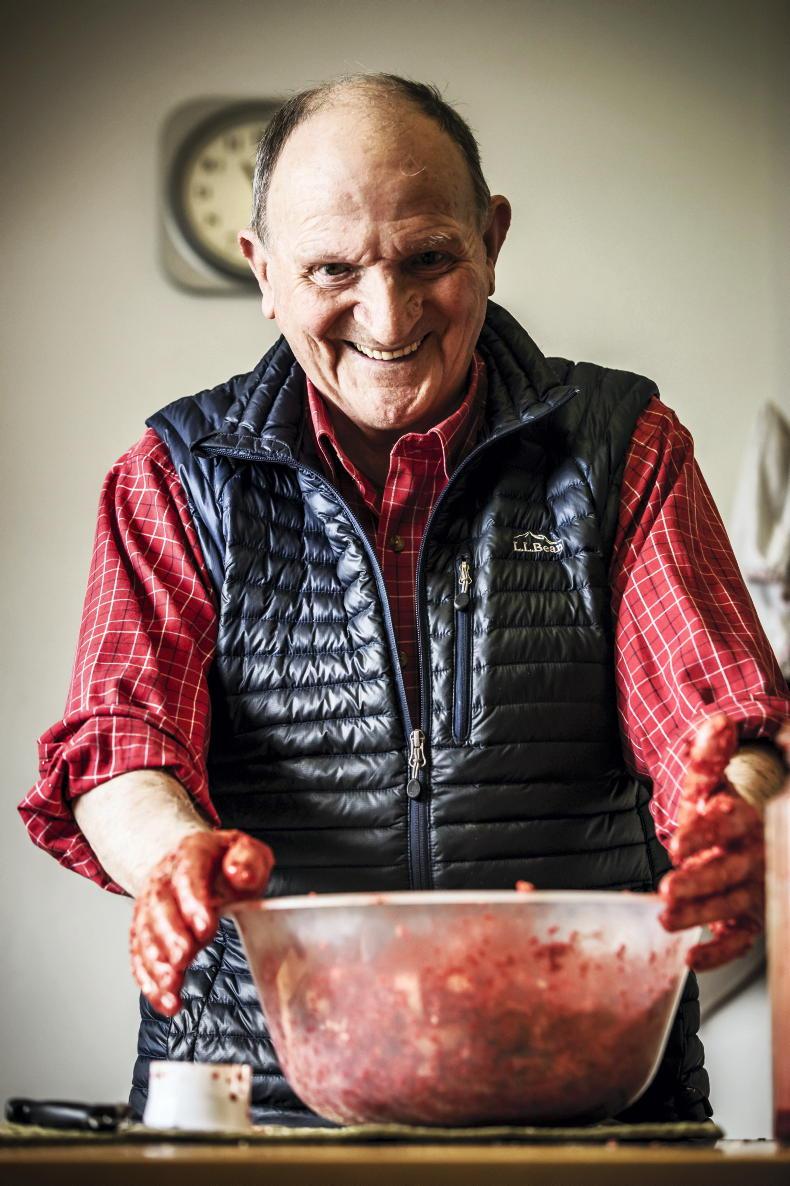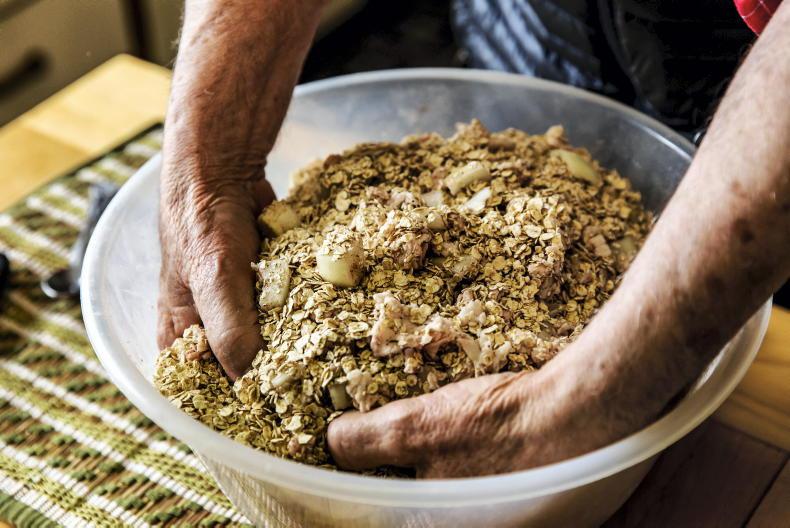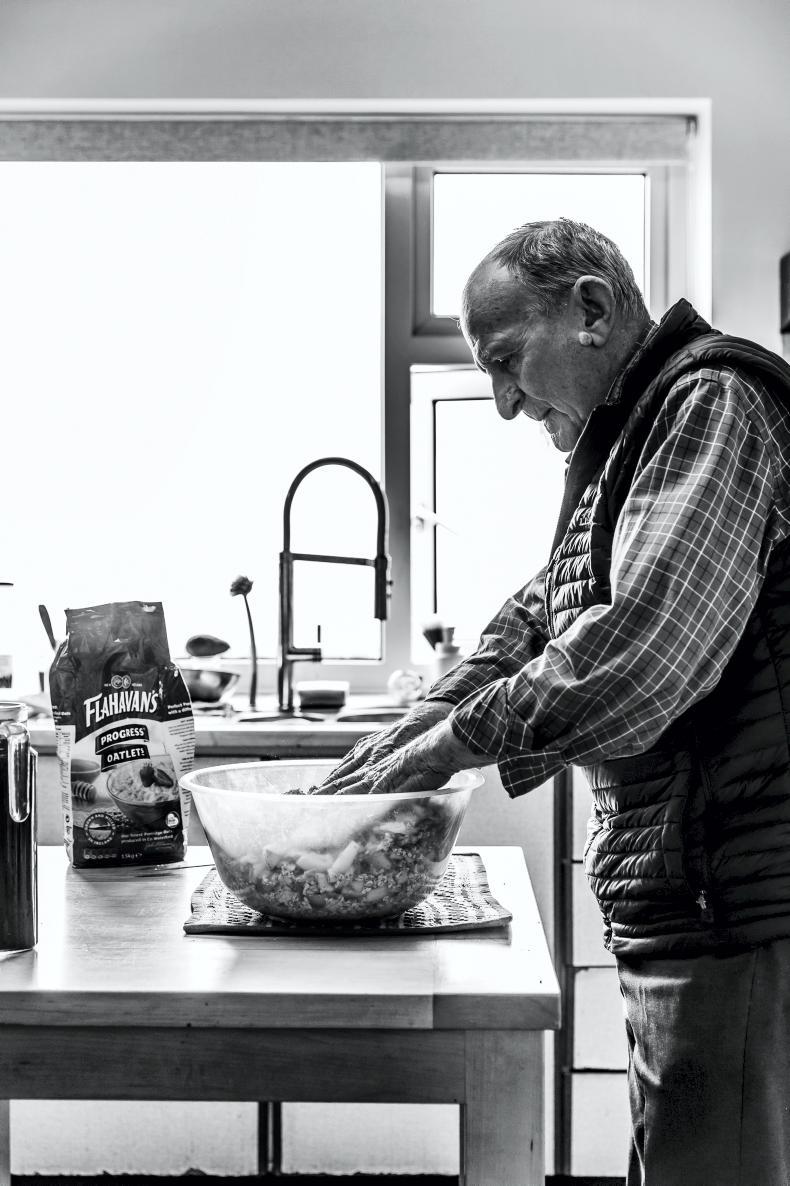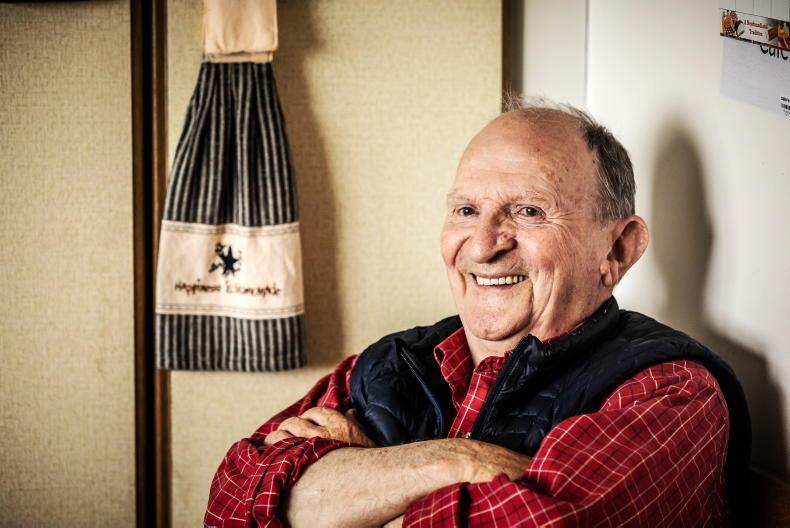The walls of the O’Malley home in Pollagh, Achill Island, tell the stories of past and present lives. They are richly steeped in memories and I am immediately drawn to them as I walk through the door of their seaside home.
Family members, some long since passed, smile from gilded frames next to handmade miniature curraghs, model fishing boats, old binoculars, trinkets from far-off lands and memorabilia of past careers.
From working on the building of the Dublin Port Tunnel, nuclear power plant construction, fishing and farming, there is seemingly little Tommy O’Malley hasn’t done in his 80-plus years.
“Fishing, farming and construction were my main careers,” he says. “I’m a civil engineer – mainly working on nuclear power stations and harbours. I worked in England and the Middle East. I lived in Libya for a few years while the King was still there … this was before the time of Gaddafi. I was there until up to 1968, and it was after that he was deposed.”
The large windows in the sitting room and kitchen, where he and his wife Anne cook together, face the roaring Atlantic. The ocean is so animated it makes the television in the corner of the sitting room seem superfluous.

\ Philip Doyle
Tommy and Anne often watch the ships pass and see whales break through the surface of the sea.
“Waves come in and over that island – and sometimes a wave will come in and roll right off the island,” Tommy says. “We call it Keel Island but it’s Sparrow Island – Inis Galun.
“We used to fish basking sharks here in Keem Bay in the ’50s and ’60s,” he continues. “They would render the liver and there was a few years where they would chop the carcasses and send them off [to the mainland] for processing, but I think half the west of Ireland complained about the smell of rotting shark as it made its journey.”

\ Philip Doyle
Tommy and Anne are not rendering shark liver today, but making belly – also called Putóg (though not usually in these parts). It’s a type of black pudding made using blood, suet, oats, onions, spices and milk all mixed together and, traditionally, stuffed into a sheep’s stomach. In former years, Anne and Tommy would use their own lamb’s blood for making belly, but today they must get the blood from a licensed abattoir – in their case, their friend who’s a butcher. The blood arrives salted to avoid coagulation. It’s not as fresh as it would have been in the past.
“We use two pounds of blood to one pound of milk,” Anne tells me. “We get the blood salted now, we didn’t previously, but it’s not as easy to get fresh blood. We never used to have a recipe, but my son wrote it down a few years ago, knowing they would someday have to make it themselves.”

\ Philip Doyle
She highlights the importance of spice in a good belly; especially the use of mace, for flavour (“it needs to be fresh,” she insists) and lamb suet, which should be well-aged. Traditionally, belly is made at Christmas time and eaten for breakfast. Unlike other black puddings found around Ireland, Anne and Tommy add dried fruit to their belly – a mix of sultanas and raisins.
“Achill isn’t easy, you know,” Anne says. “It’s not everybody’s cup of tea; Tommy was away a lot of the time and, eventually, we all went to England. Our kids went to secondary school there.”
But, as many islanders might understand, Achill called them back. Now their children are grown and Anne and Tommy are retired. They have three granddaughters who visit them regularly. As Anne chats, she dices the suet, placing the coarse chunks into a bowl. Beside it, two-litre jugs of blood are waiting to be mixed into the other ingredients.

\ Philip Doyle
Tommy comments on the changes he has seen in Achill during his lifetime – though the population has remained more or less the same. He says the change has been gradual, but no less noticeable. As he speaks, he begins to work the ingredients together in a large mixing bowl; his hands massaging the onions, oats and suet together before gradually adding in the blood.

\ Philip Doyle
“When I was growing up, in June, July and August, there were houses that were rented to families and the same families came every year,” he says. “You got to know them. The people who came to the Achill Head Hotel came for two weeks at a time and you got to know them too. Now, people are just in and out. There are still lots of the holiday homes, but nobody knows who they are.”
Gradual changes have affected their food too. Gone are the days of fishing their own herring, lobster, mackerel and salmon. Gone are the days of slaughtering their own animals. Today, the preferred method of cooking the belly is in a sous vide bag as opposed to the sheep’s belly, which is delicate and prone to tears.
But, the belly recipe remains – and will remain for generations to come. And the history of their family and their life in the tiny village of Pollagh will remain. And the walls of their home – this cosy haven set amidst an oft-harsh landscape – will continue to tell their story.
Achill Belly
Makes two large bellies
800g coarsely chopped onions
600g lamb suet, in a large dice
1kg porridge oats
1L salted lamb’s blood, mixed with some milk (two parts blood to one part milk, usually)
2 tsp black and white ground pepper
20g sea salt
1 tsp allspice
½ tsp paprika
½ tsp mace
½ tsp nutmeg
1 tsp mixed herbs
350g raisins/sultanas, mixed
2kg roasting/sous vide bags or one washed sheep’s stomach
1 You will need an eight to 10-litre mixing bowl to hold everything. Have all ingredients measured, chopped and prepped.
2 Dry mix the suet, onion, and fruit with approximately 800g oats. Add the seasonings and spices.
3 Mix thoroughly with bare hands; massage the ingredients together for up to five minutes.
4 Add approximately 900ml of blood and mix.
5 Add the remaining oats and blood to attain a soft consistency; it should not be pourable.
6 Fill into two 2kg roasting bags and squeeze all of the air out of the bags.
7 Add the bags to boiling water (a large pot of water, brought to a rolling boil, with a flat-bottomed plate added to the bottom and a tight-fitting lid).
8 Keep the tied tops of the bags out of the water by hanging them over the edge of the pot. Place the lid over the tied tops of the bag to keep them out of the water.
9 Gently boil the belly for a minimum of three hours.
10 Once the belly is cooked, let it cool completely in the bags and allow it to set overnight. It will crumble if you try to slice it while warm.
11 The following day, slice into thick slices and gently fry in butter. Serve warm.
Read more
Former Midleton master distiller is blending success in the United States
Truffles could bring opportunities for farmers planning on planting trees
The walls of the O’Malley home in Pollagh, Achill Island, tell the stories of past and present lives. They are richly steeped in memories and I am immediately drawn to them as I walk through the door of their seaside home.
Family members, some long since passed, smile from gilded frames next to handmade miniature curraghs, model fishing boats, old binoculars, trinkets from far-off lands and memorabilia of past careers.
From working on the building of the Dublin Port Tunnel, nuclear power plant construction, fishing and farming, there is seemingly little Tommy O’Malley hasn’t done in his 80-plus years.
“Fishing, farming and construction were my main careers,” he says. “I’m a civil engineer – mainly working on nuclear power stations and harbours. I worked in England and the Middle East. I lived in Libya for a few years while the King was still there … this was before the time of Gaddafi. I was there until up to 1968, and it was after that he was deposed.”
The large windows in the sitting room and kitchen, where he and his wife Anne cook together, face the roaring Atlantic. The ocean is so animated it makes the television in the corner of the sitting room seem superfluous.

\ Philip Doyle
Tommy and Anne often watch the ships pass and see whales break through the surface of the sea.
“Waves come in and over that island – and sometimes a wave will come in and roll right off the island,” Tommy says. “We call it Keel Island but it’s Sparrow Island – Inis Galun.
“We used to fish basking sharks here in Keem Bay in the ’50s and ’60s,” he continues. “They would render the liver and there was a few years where they would chop the carcasses and send them off [to the mainland] for processing, but I think half the west of Ireland complained about the smell of rotting shark as it made its journey.”

\ Philip Doyle
Tommy and Anne are not rendering shark liver today, but making belly – also called Putóg (though not usually in these parts). It’s a type of black pudding made using blood, suet, oats, onions, spices and milk all mixed together and, traditionally, stuffed into a sheep’s stomach. In former years, Anne and Tommy would use their own lamb’s blood for making belly, but today they must get the blood from a licensed abattoir – in their case, their friend who’s a butcher. The blood arrives salted to avoid coagulation. It’s not as fresh as it would have been in the past.
“We use two pounds of blood to one pound of milk,” Anne tells me. “We get the blood salted now, we didn’t previously, but it’s not as easy to get fresh blood. We never used to have a recipe, but my son wrote it down a few years ago, knowing they would someday have to make it themselves.”

\ Philip Doyle
She highlights the importance of spice in a good belly; especially the use of mace, for flavour (“it needs to be fresh,” she insists) and lamb suet, which should be well-aged. Traditionally, belly is made at Christmas time and eaten for breakfast. Unlike other black puddings found around Ireland, Anne and Tommy add dried fruit to their belly – a mix of sultanas and raisins.
“Achill isn’t easy, you know,” Anne says. “It’s not everybody’s cup of tea; Tommy was away a lot of the time and, eventually, we all went to England. Our kids went to secondary school there.”
But, as many islanders might understand, Achill called them back. Now their children are grown and Anne and Tommy are retired. They have three granddaughters who visit them regularly. As Anne chats, she dices the suet, placing the coarse chunks into a bowl. Beside it, two-litre jugs of blood are waiting to be mixed into the other ingredients.

\ Philip Doyle
Tommy comments on the changes he has seen in Achill during his lifetime – though the population has remained more or less the same. He says the change has been gradual, but no less noticeable. As he speaks, he begins to work the ingredients together in a large mixing bowl; his hands massaging the onions, oats and suet together before gradually adding in the blood.

\ Philip Doyle
“When I was growing up, in June, July and August, there were houses that were rented to families and the same families came every year,” he says. “You got to know them. The people who came to the Achill Head Hotel came for two weeks at a time and you got to know them too. Now, people are just in and out. There are still lots of the holiday homes, but nobody knows who they are.”
Gradual changes have affected their food too. Gone are the days of fishing their own herring, lobster, mackerel and salmon. Gone are the days of slaughtering their own animals. Today, the preferred method of cooking the belly is in a sous vide bag as opposed to the sheep’s belly, which is delicate and prone to tears.
But, the belly recipe remains – and will remain for generations to come. And the history of their family and their life in the tiny village of Pollagh will remain. And the walls of their home – this cosy haven set amidst an oft-harsh landscape – will continue to tell their story.
Achill Belly
Makes two large bellies
800g coarsely chopped onions
600g lamb suet, in a large dice
1kg porridge oats
1L salted lamb’s blood, mixed with some milk (two parts blood to one part milk, usually)
2 tsp black and white ground pepper
20g sea salt
1 tsp allspice
½ tsp paprika
½ tsp mace
½ tsp nutmeg
1 tsp mixed herbs
350g raisins/sultanas, mixed
2kg roasting/sous vide bags or one washed sheep’s stomach
1 You will need an eight to 10-litre mixing bowl to hold everything. Have all ingredients measured, chopped and prepped.
2 Dry mix the suet, onion, and fruit with approximately 800g oats. Add the seasonings and spices.
3 Mix thoroughly with bare hands; massage the ingredients together for up to five minutes.
4 Add approximately 900ml of blood and mix.
5 Add the remaining oats and blood to attain a soft consistency; it should not be pourable.
6 Fill into two 2kg roasting bags and squeeze all of the air out of the bags.
7 Add the bags to boiling water (a large pot of water, brought to a rolling boil, with a flat-bottomed plate added to the bottom and a tight-fitting lid).
8 Keep the tied tops of the bags out of the water by hanging them over the edge of the pot. Place the lid over the tied tops of the bag to keep them out of the water.
9 Gently boil the belly for a minimum of three hours.
10 Once the belly is cooked, let it cool completely in the bags and allow it to set overnight. It will crumble if you try to slice it while warm.
11 The following day, slice into thick slices and gently fry in butter. Serve warm.
Read more
Former Midleton master distiller is blending success in the United States
Truffles could bring opportunities for farmers planning on planting trees











 This is a subscriber-only article
This is a subscriber-only article










SHARING OPTIONS: